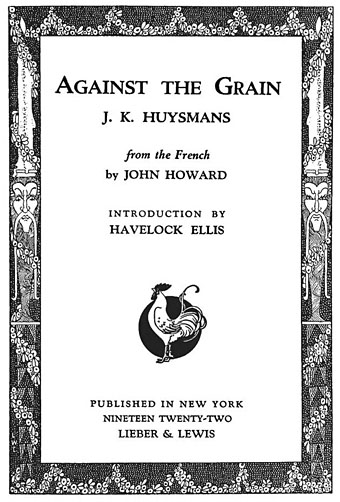
I’ve always preferred Against Nature as an English translation of Huysmans’ À rebours, it’s a snappier and more provocative title than Against the Grain which these days might be taken as a prescription for a paleo diet.
À rebours this month is also the title of an art exhibition opening Venus Over Manhattan, a new exhibition space in New York City created by art collector and writer Adam Lindemann:
À rebours at Venus over Manhattan explores the notion of “against the grain” through a selection of more than 50 works including African fetishes. The artists represented range from Odilon Redon – the favorite of the book’s protagonist – to Henri Fuseli, Gustave Moreau, Felicien Rops, Franz von Stuck, Lucas Samaras, William Copley, Jeff Koons, Glenn Brown, Salvador Dalí, Walter Dahn, David Hammons and Bernard Buffet, as well as Jeni Spota, Andra Ursuta and Gavin Kenyon.
A document detailing the exhibits may be downloaded in pdf form here. Few of the works have any direct connection with Huysmans’ novel but there are some book covers there I hadn’t seen before. The exhibition runs to 30th June, 2012. (Thanks to @supervert for the tip.)
Looking around for some more Huysmans-related imagery turned up the uncredited title page above (the entire book is here), and the following quote from Theophile Gautier which Havelock Ellis uses in his introduction. Gautier was discussing Baudelaire but, as Ellis says, it’s an excellent statement of the principles of Decadence as an artistic concept:
The poet of the Fleurs du Mal loved what is improperly called the style of decadence, and which is nothing else but art arrived at that point of extreme maturity yielded by the slanting suns of aged civilisations: an ingenious complicated style, full of shades and of research, constantly pushing back the boundaries of speech, borrowing from all the technical vocabularies, taking colour from all palettes and notes from all keyboards, struggling to render what is most inexpressible in thought, what is vague and most elusive in the outlines of form, listening to translate the subtle confidence of neurosis, the dying confessions of passion grown depraved, and the strange hallucinations of the obsession which is turning to madness. The style of decadence is the ultimate utterance of the Word, summoned to final expression and driven to its last hiding-place. One may recall in this connection the language of the later Roman Empire, already marbled with the greenness of decomposition, and, so to speak, gamy, and the complicated refinements of the Byzantine School, the last forms of Greek art falling into deliquescence. Such indeed is the necessary and inevitable idiom of peoples and civilisations in which factitious life has replaced natural life, and developed unknown wants in men. It is, besides, no easy thing, this style disdained of pedants, for it expresses new ideas in new forms, and in words which have not yet been heard. Unlike the classic style it admits shadow… One may well imagine that the fourteen hundred words of the Racinian vocabulary scarcely suffice the author who undertakes the laborious task of rendering ideas and things in their infinite complexity and multiple coloration.
Previously on { feuilleton }
• À Rebours illustrated
• Arthur Zaidenberg’s À Rebours

“Against Nature” may be snappier but “Against the Grain” is much more accurate. “Backwards” or “Upstream” would also be pretty spot on translations although they make unfortunate titles.
I saw an exhibition in Paris in 2006 called Le Voyage intérieur which aimed at recreating des Esseintes’ house room by room through contemporary art. An intriguing idea, a so-so reality. The catalogue has contributions from Richard Hawkins, Michael Bracewell and Philip Hoare, among others.
michelangelo: Against the Grain is still better than the common English translation of Huysmans’ Là-Bas which I have with the euphemistic title of Down There.
James: Yes, that is an intriguing idea. The problem with trying to make a literary idea real is that brute reality intervenes in ways which doesn’t happen when you’re reading a description. And Des Esseintes in the novel would have had far more time to labour over minute choices and details than any curator, with those details selected to match the size of room, its light (or lack of it) and so on.
Thanks for telling us about this show which I finally saw last week. Unfortunately the show received most of its publicity due to the brazen theft of a Dali by a man who simply took it away in a shopping bag. What made the show unique was that space was dim and only strategically lit. One of the first pieces seen upon entering the gallery was a chair on its side, fit with a gas burner (Violette Banks) which was so much more mysterious than the photos of that work. It was a wonderful introductory show for a promising gallery.